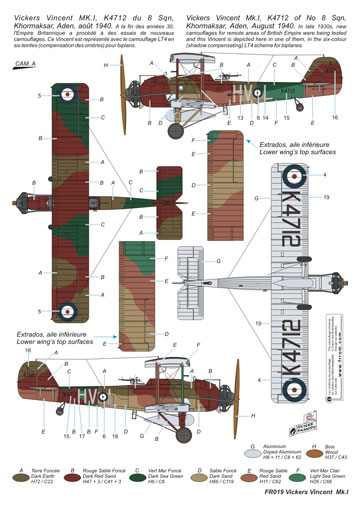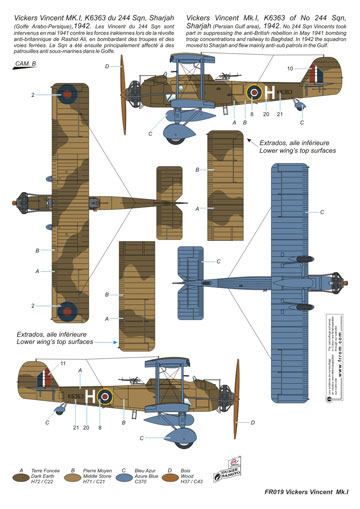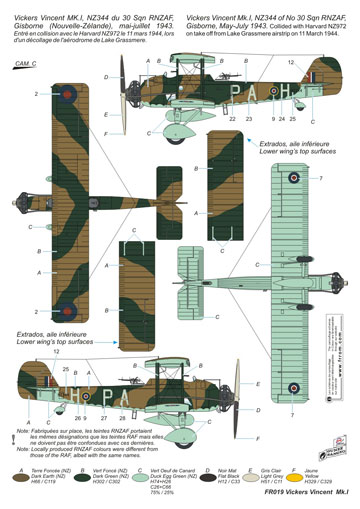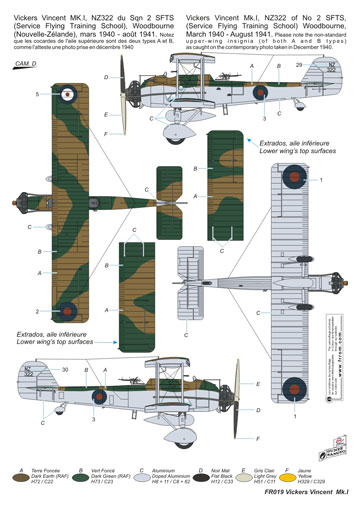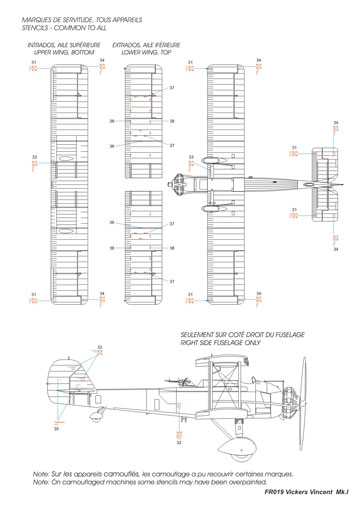FR019 Vickers Vincent Mk I
History:
The Vickers Vincent replaced the Westland Wapitis and Fairey IIIF in the General Purpose (GP) role; a role that was very involved with policing the British Empire. Vickers developed the Vincent from their Vildebeest torpedo-bomber; a design which first flew in April 1928 and entered RAF service in 1932. The main changes to the Vildebeest were simple: the torpedo gear was removed, a long-range fuel tank slung in its place, and a message hook added. Vincents also had to carry a variety of other gear to perform their GP role and Army cooperation duties. Items like pyrotechnics, bombs, sleeping bags, ground radio and collapsible long-range aerial masts all had to be stowed away or slung under wings. A Vildebeest modified for the GP role began an overseas tour in December 1932; then a year later 51 GP Vildebeests were ordered. However, because the GP role was so different from torpedo bombing the name Vincent was used for these aircraft. In total, 196 Vincents were delivered between July 1934 and October 1936; 84 of these were still in service at the outbreak of WW2.
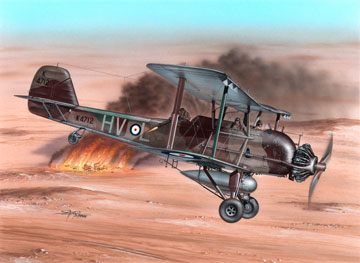
No 8 Sqn based in Aden was sent to British Somaliland in June 1940 after Italy declared war on Britain. Its 12 Vincents then saw some action in Eritrea. No 8 Sqn later returned to Aden, where its Vincents remained in use until April 1942. Vincents of No 244 Sqn based in Sarjah fighted against the coup by Rashid Ali in Iraq, they defended the Habbaniyah Air Base which was under siege in May 1941. Vincents were flown by No 244 Sqn until as late as November of 1942. No 47 Sqn flew Vincents until mid-1940 in the Sudan, where they fought the Italians in East Africa. It is thought that at least one captured Vincent was used by the Iraqis.
The RAF replaced 60 or so of its Vincents with more modern types in 1939. These Vincents were then shipped to the RNZAF in two batches, the first of which arrived in New Zealand in July 1939. They appear to have been delivered in the pre-war RAF scheme of overall aluminium dope with pre-war type roundels. They had also arrived with RAF serials, but by early 1940 these were replaced by RNZAF serials; NZ301 to NZ316. In mid-1941 the survivors of this first batch appear to have received the wartime disruptive camouflage scheme applied to Vildebeests and Vincents. This consisted of New Zealand’s version of Dark Earth and Dark Green upper-surfaces Duck Egg Green undersides that had a low wavy demarcation line on the fuselage. The two upper colours appear to be very close matches for their RAF equivalents, but the Duck Egg Green was quite different to Sky Type S, being a very rich and saturated colour close to FS.24260. The Type-B roundels were placed in the standard six positions initially.
The rest of the RNZAF’s Vincents arrived in November 1939. They seem to have worn a camouflage pattern of Dark Earth and Dark Green over what appears to be aluminium dope undersides, with a high demarcation line on the fuselage. They appear to have had Type-B roundels in six positions and no fin flashes. RNZAF serials of NZ317 to NZ360 replaced the RAF’s, and were painted on the rudders and fuselage sides. These aircraft were later repainted around mid-1941 in the same New Zealand colours with the lower wavy demarcation applied to the first batch. They initially kept the Type-B roundels; but later received a variation of the Types-A& C roundels on the fuselage and under-wing positions, with serials on the fuselage only, and an unequal width fin flash. Many of the Vincents received squadron codes when they were issued to the general reconnaissance squadrons. These codes were originally in Sky Type-S or a variation of this colour, and sat either side of the fuselage roundels.
Differences with kit FR017 Vickers Vildebeest MK III (parts):
- Additional parts in injected plastic: belly tank, wheels, bomb racks, message hook. The fuselage inner details have been improved according to the Vincents under restoration in New Zealand.
- New parts in resin (engine redone, 120 Lbs bombs).
- The torpedo is still available (never mounted on Vincents) but the photo-etched torpedo support is not provided any more.
Surviving planes:
To our knowledge, only two Vincents are surviving today. These two Vincents are under restoration in New Zealand, one of them in the Air Force Museum of New Zealand, the second in Subritzky family collection at Dairy Flat, north of Auckland, NZ.
Our warmest thanks to Air Force Museum of New Zealand:
- Mr Nathan Bosher, Safety & Surface Technician, Restoration section
- Mr Peter Mossong
Mr Peter Mossong's Website, on the RNZAF in the Pacific in WW2: http://rnzaf.hobbyvista.com/index.html
